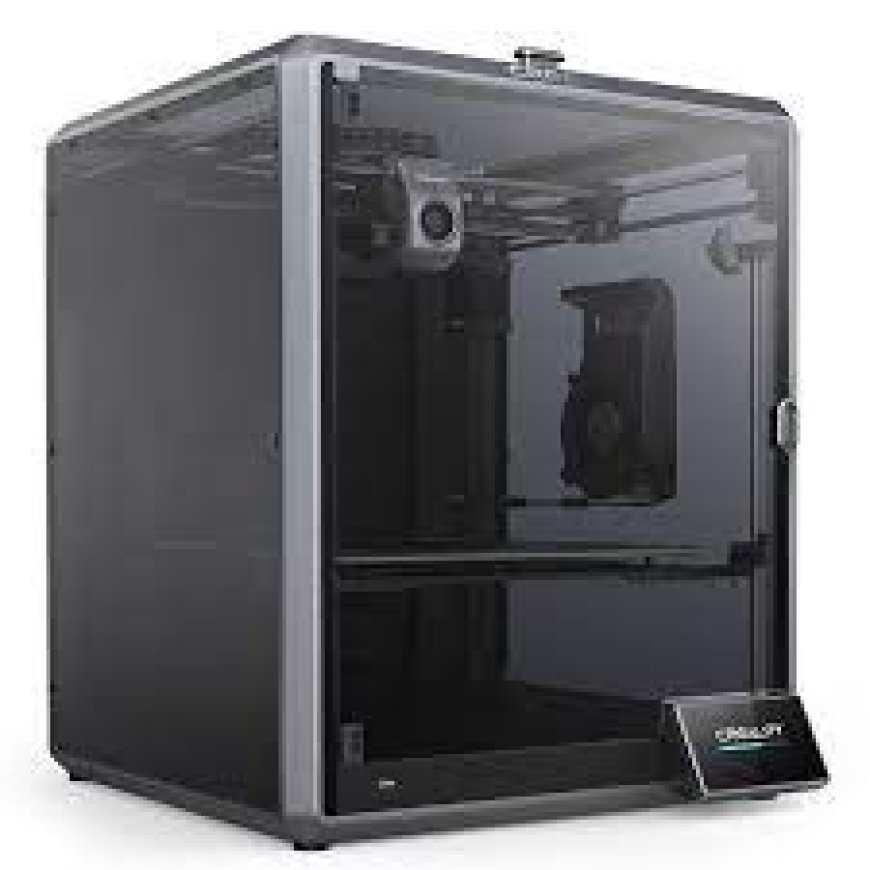The Creality K1 Max
Creality, a renowned name in the world of 3D printing, has once again raised the bar with the launch of the K1 Max. This new model is not just an upscaled version of its predecessor, the K1, but a more advanced and feature-rich 3D printer. Boasting a significant build volume of 300 x 300 x 300mm, the K1 Max stands out with its Core XY configuration, offering an enclosed single color printing experience. This article delves into the intricate details and innovative features of the Creality K1 Max, providing a comprehensive overview for enthusiasts and professionals alike.

Enhanced Features and Deluxe Additions
One of the most striking aspects of the K1 Max is its speed, capable of reaching up to 600mm/s, setting it apart in the market. However, speed is just the tip of the iceberg. The printer incorporates cutting-edge technology like LIDAR and an AI camera, which are instrumental in monitoring print jobs and alerting users to any potential failures. This integration of technology marks a significant step forward in the realm of 3D printing, offering reliability and precision.
Also check GAMDIAS Kratos M1-750W PSU Review: Balancing Aesthetics and Affordability
Firmware and Community Response
Creality's decision to run a limited version of Klipper firmware on the K1 Max initially drew some criticism from the community. In response to this backlash, Creality released an open version of the firmware, demonstrating their commitment to community feedback and open-source principles. For those interested in exploring the full capabilities of Klipper, the option to install the vanilla version is available, though it requires manual installation.
Competitive Pricing and Comparison
When it comes to pricing, the K1 Max is positioned competitively at $899. This price point is particularly notable when compared to similar deluxe models like the Bambu Lab X1 Carbon, which is priced higher but offers a smaller build volume. The K1 Max not only excels in its price-to-feature ratio but also outperforms competitors like the Bambu Lab P1S in terms of speed and user interface. It also provides options for USB and LAN printing, steering clear of unreliable cloud printing.
Performance and Filament Handling
In testing, the K1 Max demonstrated impressive performance. Its ability to handle high-temperature filaments with ease and produce fast, smooth, and clean prints, positions it as a top contender in the 3D printer market. These capabilities make it an ideal choice for both hobbyists and professionals seeking a reliable and versatile 3D printing solution.
Unboxing and Setup
The Creality K1 Max comes with an all-inclusive setup kit. This includes essential tools for maintenance, side cutters, a plastic scraper, and a USB stick. Adding to the convenience, a full spool of white Creality Hyper PLA is included, ensuring that users can start their printing journey immediately. The package also contains a PDF manual, Creality Slicer software, and sample models in both .gcode and .stl formats, accompanied by a helpful instructional video.
Design and Build
The K1 Max sports a modern, fully enclosed design typical of Core XY printers. Its build plate, measuring 300 x 300 mm with a 300 mm build height, resembles the size of Creality's older CR10 models. The printer features a smooth PEI coated sheet that requires a glue stick for adhesion. The inclusion of a flat glass lid, a carbon filter, a camera, and LiDAR further enhances its design and functionality. These components play a crucial role in bed leveling and ensuring the perfection of the first layer, leveraging AI to scan and monitor the printing process.
Advanced Monitoring and User Interaction
The K1 Max's advanced features, such as LiDAR and the camera, facilitate exceptional monitoring capabilities, although they require activation and are dependent on the Creality Cloud for full functionality. In LAN-only mode, users might need to rely on traditional methods of print monitoring. The printer's firmware, a modified version of Klipper by Creality, has been a subject of discussion in the community. Following feedback, Creality made the firmware open source, allowing users the flexibility to switch to a vanilla version of Klipper if desired.
Nozzle Design and Material Handling
Creality's approach to nozzle design is unique, with similarities to the E3D Volcano but with distinct differences. The official K1 nozzles are now more accessible, thanks to their availability on platforms like Amazon. However, the printer's rear-mounted spool holder design has drawn some criticism, primarily due to the inconvenience it poses in accessing the filament rack and runout sensor. In response to this, some users have opted to print a standalone filament rack, a design conveniently included with the printer, to enhance the usability and handling of materials.
Conclusion
The Creality K1 Max emerges as a formidable player in the 3D printing industry, offering a blend of speed, advanced features, and user-friendly design. Its competitive pricing, coupled


































